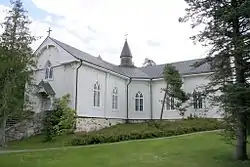Askola
Askola (Finnish pronunciation: [ˈaskola]) is a municipality of Finland. It is located in the Uusimaa region. The municipality has a population of 4,941 (31 July 2020)[2] and covers an area of 218.03 square kilometres (84.18 sq mi) of which 5.61 km2 (2.17 sq mi) is water.[1] The population density is 23.26 inhabitants per square kilometre (60.2/sq mi). Monninkylä is the largest village of municipality in terms of population (1,326 inhabitants).[6] Neighbouring municipalities are Myrskylä, Mäntsälä, Pornainen, Porvoo and Pukkila.
Askola | |
|---|---|
Municipality | |
| Askolan kunta Askola kommun | |
 Askola church. | |
 Coat of arms | |
 Location of Askola in Finland | |
| Coordinates: 60°31.7′N 025°36′E | |
| Country | |
| Region | Uusimaa |
| Sub-region | Porvoo sub-region |
| Charter | 1896 |
| Government | |
| • Municipal manager | Esko Rautiainen |
| Area (2018-01-01)[1] | |
| • Total | 218.03 km2 (84.18 sq mi) |
| • Land | 212.42 km2 (82.02 sq mi) |
| • Water | 5.61 km2 (2.17 sq mi) |
| Area rank | 260th largest in Finland |
| Population (2020-07-31)[2] | |
| • Total | 4,941 |
| • Rank | 174th largest in Finland |
| • Density | 23.26/km2 (60.2/sq mi) |
| Population by native language | |
| • Finnish | 95.5% (official) |
| • Swedish | 2.8% |
| • Others | 1.7% |
| Population by age | |
| • 0 to 14 | 20.6% |
| • 15 to 64 | 66.2% |
| • 65 or older | 13.2% |
| Time zone | UTC+02:00 (EET) |
| • Summer (DST) | UTC+03:00 (EEST) |
| Municipal tax rate[5] | 19% |
| Climate | Dfb |
| Website | www.askola.fi |
The Askola parish was part of Porvoo until 1639, when it became a chapel parish, and finally became independent in 1896. The Askola church was completed in 1799.[7]
The coat of arms of the municipality seeks influence from the history of the parish; the millstone is reminiscent of the Askolas's many mills and famous breads, while the roses of the coat of arms refer to Finnish author Johannes Linnankoski, who was born and influenced in Askola, whose most famous work was The Song of the Blood-Red Flower.
The municipality is unilingually Finnish. Askola is one of three municipalities in the Uusimaa region that do not have a Swedish name; the others are Nurmijärvi and Mäntsälä.
Geography
The most significant waters in Askola includes the River Porvoo flowing from the center of Askola between Orimattila and Porvoo, and eleven lakes in the eastern part of the municipality.[8]
Villages
Askola (Kirkonkylä), Huuvari, Juornaankylä, Korttia, Monninkylä, Nalkkila, Nieto, Puharonkimaa, Särkijärvi, Tiilää, Vahijärvi and Vakkola.
Politics
Results of the 2011 Finnish parliamentary election in Askola:
- True Finns 32.1%
- Centre Party 21.9%
- National Coalition Party 16.1%
- Social Democratic Party 14.8%
- Green League 5.4%
- Left Alliance 5.0%
- Christian Democrats 1.8%
- Swedish People's Party 1,6%
People born in Askola
- Juho Laakso (1854 – 1915)
- Erkki Peltonen (1861 – 1942)
- Johannes Linnankoski (1869 – 1913)
- Oskar Kumpu (1889 – 1935)
References
- "Area of Finnish Municipalities 1.1.2018" (PDF). National Land Survey of Finland. Retrieved 30 January 2018.
- "Suomen virallinen tilasto (SVT): Väestön ennakkotilasto [verkkojulkaisu]. Heinäkuu 2020" (in Finnish). Statistics Finland. Retrieved 13 September 2020.
- "Population according to language and the number of foreigners and land area km2 by area as of 31 December 2008". Statistics Finland's PX-Web databases. Statistics Finland. Retrieved 29 March 2009.
- "Population according to age and gender by area as of 31 December 2008". Statistics Finland's PX-Web databases. Statistics Finland. Retrieved 28 April 2009.
- "List of municipal and parish tax rates in 2011". Tax Administration of Finland. 29 November 2010. Retrieved 13 March 2011.
- "Monninkylä in Askola (Uusimaa)". City Population. Retrieved August 7, 2019.
- Askolan kirkko Askolan Seurakunta (in Finnish)
- Askolan luonto ja historia Askolan 4H
External links
![]() Media related to Askola at Wikimedia Commons
Media related to Askola at Wikimedia Commons
- Municipality of Askola – Official website

